Table of Contents
HUMAN EVOLUTION
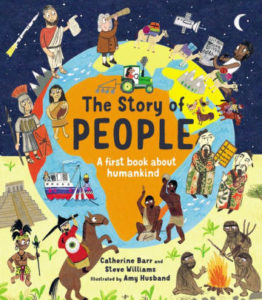 |
Catherine Barr’s The Story of People (Frances Lincoln Children’s Books, 2019) is a picture=book history of the human race, beginning with our evolutionary ancestors. For ages 5-8. |
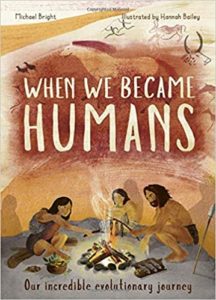 |
Michael Bright’s When We Became Humans (words & pictures, 2019) is the story of human evolution from our distant ancestors to Homo sapiens. For ages 7-11. |
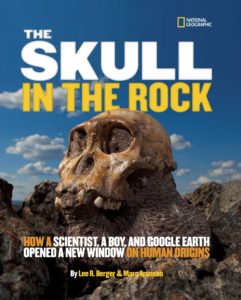
|
By Lee Berger and Marc Aronson, The Skull in the Rock (National Geographic Children’s Books, 2012) is the story of how nine-year-old Matthew Berger – on a fossil-hunting expedition with his paleoanthropologist father in South Africa – found a pair of two-million-year-old fossil skulls belonging to a new species of human being. The book, illustrated with color photographs, meshes evolutionary history with a real-life adventure story. For ages 10-14. |
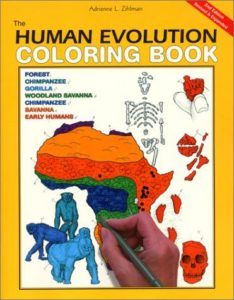
|
By Adrienne Zihlman and Carla Simmons, The Human Evolution Coloring Book (HarperCollins, 2001) is a very detailed and sophisticated teach-yourself tour of human evolution (while doing a lot of complex coloring), beginning with a geologic timeline, then proceeding through evolutionary genetics, primate diversification and evolution, and a chronology of hominid and early human fossils. For ages 13 and up. |
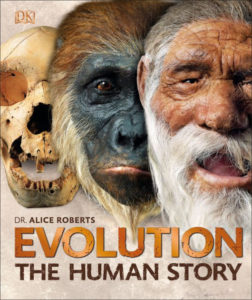 |
By Alice Roberts, Evolution: The Human Story (DK, 2018) traces human evolution from our earliest primate ancestors through migration out of Africa and the agricultural evolution. 250+ pages long. For teens and up. |
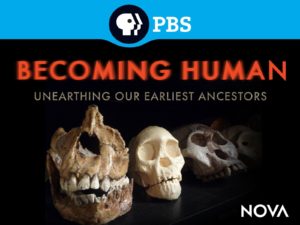 |
Becoming Human is an interactive documentary that covers four million years of human evolution with guide Donald Johanson, discoverer of Lucy. Included are an interactive timeline, an online exercise on bipedalism (what bone changes helped us walk upright?), and a chromosome comparison “adventure” in which participants compare banding patterns on the chromosomes of humans and apes. |
| NeoK12’s Human Evolution is a collection of short videos, among them the 13-part “Journey of Man: A Genetic Odyssey” and the 5-part “Neanderthal.” | |
| From the Smithsonian National Museum of Natural History, Introduction to Human Evolution has background information, a detailed downloadable Educator’s Guide for grades 5-12, a “How do we know…?” list of questions, lesson plans, and fun facts. |
THE MONKEY TRIAL
| The Scopes Trial (Interact) is an historical simulation, in which kids take on the roles of judge, jury members, attorneys (William Jennings Bryan and Clarence Darrow), witnesses, and, of course, the accused, Scopes himself. Included are detailed instructions and background readings. | |
 |
Project: try reliving American history through letterwriting! Kids pair up and, as correspondents, take on character roles and exchange informational letters about crucial historical events. Try World War I, the 19th Amendment, or the Scopes trial. |
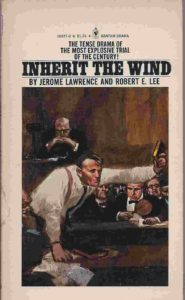
|
By Jerome Lawrence and Robert E. Lee, Inherit the Wind (Ballantine Books, 2007) is a superb play based on the Scopes Monkey Trial of 1925, in which Tennessee teacher John Scopes was threatened with jail for teaching evolution in the public school. For ages 12 and up. |
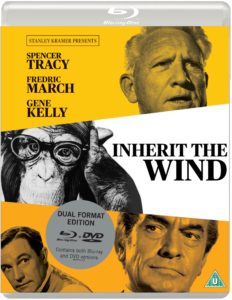
|
A dramatized view of the trial is presented in the 1960 film Inherit the Wind, based on the Lawrence and Lee play, and starring Spencer Tracy (for the defense) and Frederic March (for the prosecution). |
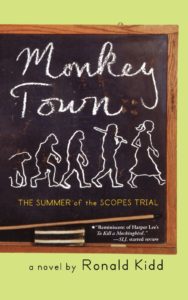
|
In Ronald Kidd’s Monkey Town: The Summer of the Scopes Trial (Simon Pulse, 2011), 15-year-old Frances Robinson has a crush on handsome teacher Johnny Scopes – just as her father cooks up a scheme to bring publicity to the town of Dayton, Tennessee, by prosecuting Scopes for teaching evolution in the public school. The trial, which quickly gets out of hand, unfolds as seen through Frances’s eyes. For ages 11 and up. |
EVOLUTION IN FICTION
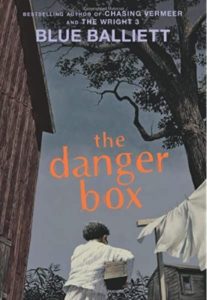
|
In Blue Balliett’s The Danger Box (Scholastic, 2012), 12-year-old Zoomy – so near-sighted that he’s legally blind – has been raised by his grandparents. When his alcoholic father unexpectedly shows up and leaves Zoomy a stolen box that contains an old notebook, Zoomy is determined to learn more. The identity of the author of the mysterious notebook is the major mystery of the book – hints are provided through Zoomy’s personal newspaper, the Gas Gazette – though Zoomy and his friend Lorrol must also solve plenty of puzzles and cope with a criminal who wants the box and notebook back. The secret scientist (Spoiler!) is Charles Darwin. For ages 9-13. |
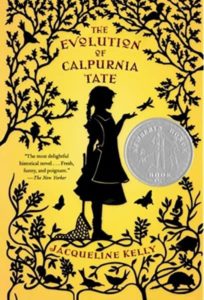
|
In Jacqueline Kelly’s The Evolution of Calpurnia Tate (Square Fish, 2011), 11-year-old Calpurnia – known to her family as Callie Vee – lives with her parents and six brothers on a cotton plantation in Texas in 1899. (Her favorite brother is Harry, the oldest, but I have a soft spot for ten-year-old Travis, who names his kittens after gunslingers.) As the book progresses, bright and curious Callie Vee becomes fascinated with science and disenchanted with the ladylike future her mother has planned for her. Luckily she finds a kindred spirit in her curmudgeonly grandfather. After Callie Vee is forbidden to check Darwin’s Origin of Species out of the library, her Granddaddy not only lends her his copy, but starts taking her with him on his specimen-collecting expeditions. A wonderful story of a science-minded girl coming into her own. I’d say Caddie Woodlawn with a science twist – but Callie Vee is wholly unique. Highly recommended. For ages 10 and up. |
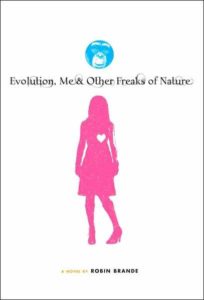
|
In Robin Brande’s Evolution, Me, and Other Freaks of Nature (Ember, 2009), 14-year-old Mena is having a tough time in school – she’s been tossed out of her evangelical church for blowing the whistle on some nasty anti-gay behavior – and now the conflict ratchets up when her science teacher, Ms. Shepherd, begins a study unit on evolution. Ms. Shepherd inevitably ends up in conflict with the influential fundamentalist pastor of Mena’s ex-church, and Mena herself – who blogs as “Bible Grrrl” – must come to terms with what she believes. For ages 12 and up. |
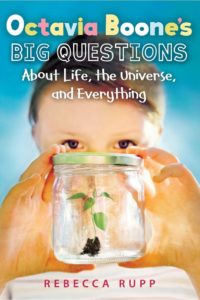
|
Similarly, in Rebecca Rupp’s Octavia Boone’s Big Questions About Life, the Universe, and Everything (Candlewick, 2010), seventh-grader Octavia’s parents have separated after her mother becomes committed to a fundamentalist group called the Redeemers. Octavia disagrees with the Redeemers’ take on gender roles, holidays, cosmology, and evolution – though she finds an unexpected friend in the Redeemers’ understanding Pastor Bruno – and eventually, too, comes to terms with differences in belief. Ultimately, she finds that she agrees with Henry David Thoreau: “The universe is wider than our views of it.” For ages 10 and up. |
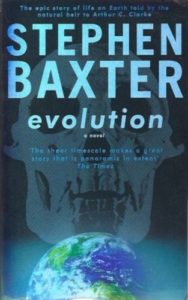
|
Stephen Baxter’s Evolution (Del Rey, 2004) is a 600+-page novelization of some 600 million years of evolution, beginning with a primitive pre-primate (named Purga) skittering around the feet of the dinosaurs. The frame story – set in 2030 – centers around paleontologist Joan Useb and a group of fellow scientists trying to save the biosphere and stave off human extinction. (They don’t.) The story then continues on into a far-distant future. An interesting, though depressing, read for teens and adults. |
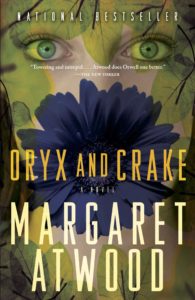
|
The future evolution of mankind is a popular theme in science fiction novels, featured in everything from H.G. Wells’s The Time Machine to the X-Men. Margaret Atwood’s outstanding Oryx and Crake (Anchor Books, 2004) is the story of Jimmy (the “Snowman”), possibly the last human on Earth, and his best friend, Crake, whose bioengineering experiments brought about the extinction of humans and the rise of the Crakers, a genetically altered new race of his own devising. Lots of discussion potential for teens and adults. |
